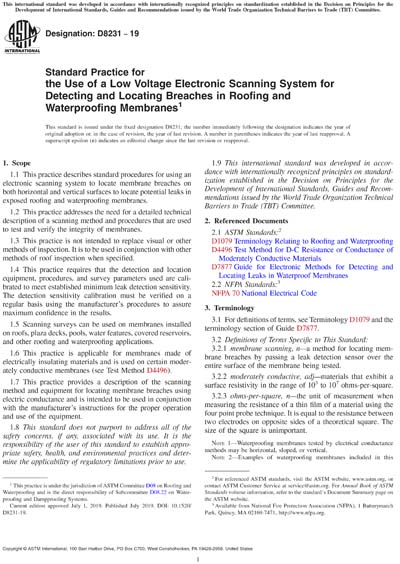Most recent
ASTM D8231-19
Standard Practice for the Use of a Low Voltage Electronic Scanning System for Detecting and Locating Breaches in Roofing and Waterproofing Membranes
1.1 This practice describes standard procedures for using an electronic scanning system to locate membrane breaches on both horizontal and vertical surfaces to locate potential leaks in exposed roofing and waterproofing membranes.
1.2 This practice addresses the need for a detailed technical description of a scanning method and procedures that are used to test and verify the integrity of membranes.
1.3 This practice is not intended to replace visual or other methods of inspection. It is to be used in conjunction with other methods of roof inspection when specified.
1.4 This practice requires that the detection and location equipment, procedures, and survey parameters used are calibrated to meet established minimum leak detection sensitivity. The detection sensitivity calibration must be verified on a regular basis using the manufacturer’s procedures to assure maximum confidence in the results.
1.5 Scanning surveys can be used on membranes installed on roofs, plaza decks, pools, water features, covered reservoirs, and other roofing and waterproofing applications.
1.6 This practice is applicable for membranes made of electrically insulating materials and is used on certain moderately conductive membranes (see Test Method D4496).
1.7 This practice provides a description of the scanning method and equipment for locating membrane breaches using electric conductance and is intended to be used in conjunction with the manufacturer’s instructions for the proper operation and use of the equipment.
1.8 This standard does not purport to address all of the safety concerns, if any, associated with its use. It is the responsibility of the user of this standard to establish appropriate safety, health, and environmental practices and determine the applicability of regulatory limitations prior to use.
1.9 This international standard was developed in accordance with internationally recognized principles on standardization established in the Decision on Principles for the Development of International Standards, Guides and Recommendations issued by the World Trade Organization Technical Barriers to Trade (TBT) Committee.
Content Provider
ASTM International [astm]






